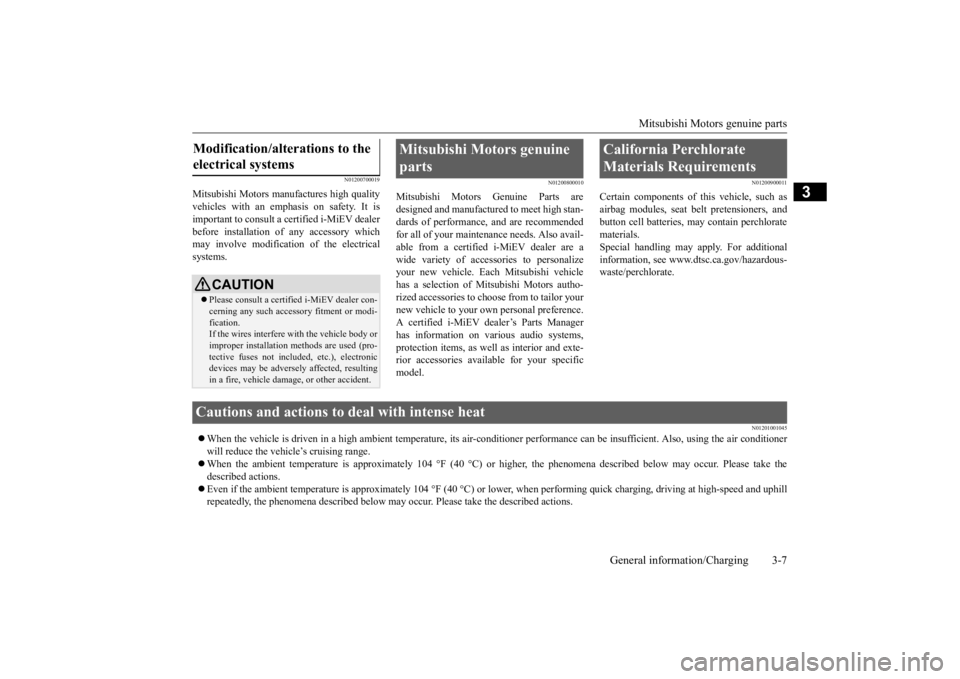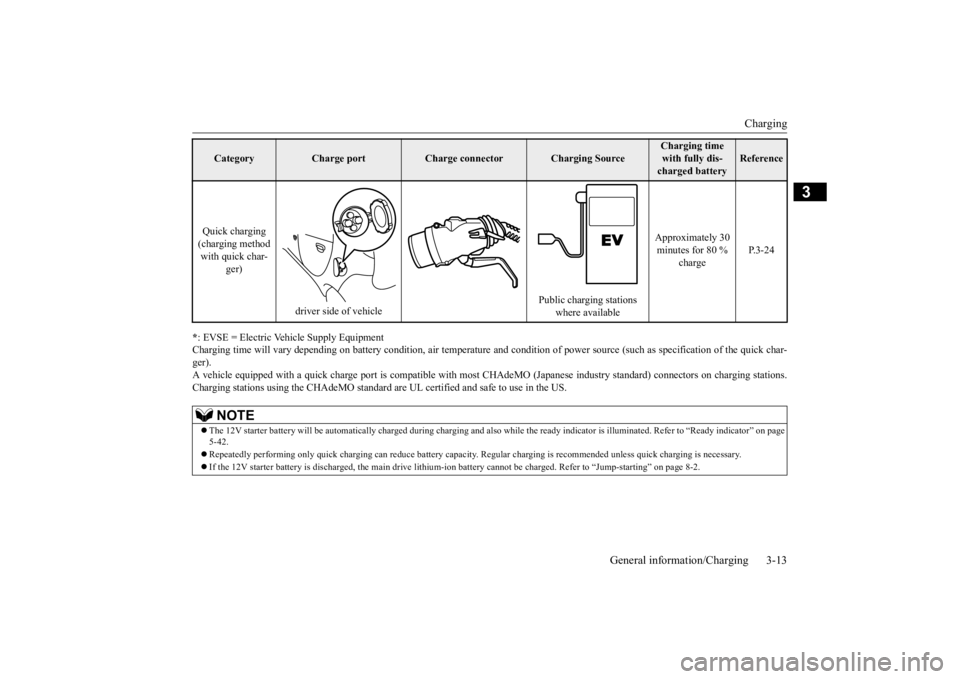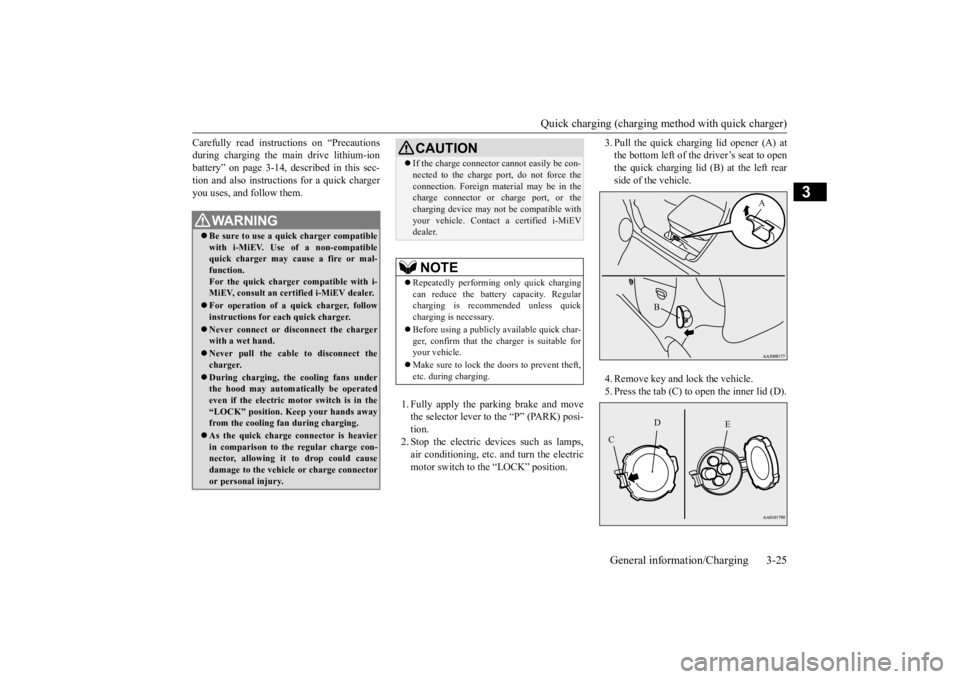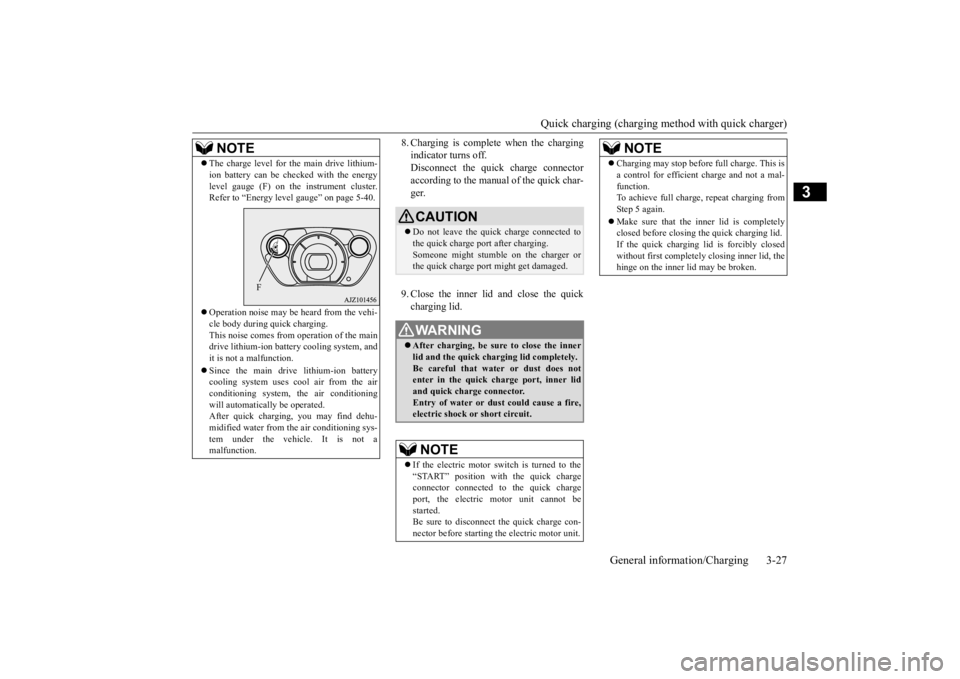air condition MITSUBISHI iMiEV 2015 Owner's Manual (in English)
[x] Cancel search | Manufacturer: MITSUBISHI, Model Year: 2015, Model line: iMiEV, Model: MITSUBISHI iMiEV 2015Pages: 262, PDF Size: 26.84 MB
Page 4 of 262

Instruments and controls (Instrument panel)
Overview 1-2
1
N00100202586
Instruments and controls (Instrument panel)
Hazard warning flasher switch P.5-47
Supplemental restraint system (SRS) - airbag (for front passenger’s seat) P.4-21
Audio P.7-11
Side vents P.7-2 Cup holder P.5-55 Glove compartment P.5-55
Center vents P.7-2
Hood release lever P. 9 - 3
Air conditioning P. 7 - 4
Card holder P.5-55 Electric rear window defogger switch P.5-50
12 V power outlet P.5-51
Selector lever P.5-21
Heated front passenger’s seat switchP. 4 - 4
Parking brake lever P.5-16
Quick charging lid opener P.3-24
Cup holder P.5-55
BK0209800US.book 2 ページ 2014年1月14日 火曜日 午前9時26分
Page 22 of 262

Mitsubishi Motors genuine parts
General information/Charging 3-7
3
N01200700019
Mitsubishi Motors manufactures high quality vehicles with an em
phasis on safety. It is
important to consult a
certified i-MiEV dealer
before installation of
any accessory which
may involve modificati
on of the electrical
systems.
N01200800010
Mitsubishi Motors Genuine Parts are designed and manufactured to meet high stan- dards of performance, and are recommendedfor all of your maintenance needs. Also avail- able from a certified i-MiEV dealer are a wide variety of accessories to personalizeyour new vehicle. Each Mitsubishi vehicle has a selection of Mitsubishi Motors autho- rized accessories to choose from to tailor your new vehicle to your ow
n personal preference.
A certified i-MiEV de
aler’s Parts Manager
has information on various audio systems, protection items, as well
as interior and exte-
rior accessories available for your specificmodel.
N01200900011
Certain components of this vehicle, such as airbag modules, seat belt pretensioners, and button cell batteries, ma
y contain perchlorate
materials. Special handling may apply. For additional information, see www.d
tsc.ca.gov/hazardous-
waste/perchlorate.
N01201001045
When the vehicle is driven in a high ambient temperature, it
s air-conditioner performance can be
insufficient. Also, using the
air conditioner
will reduce the vehicle’s cruising range. When the ambient temperature is approximately 104 °F (40 °C) or
higher, the phenomena described be
low may occur. Please take th
e
described actions. Even if the ambient temperature is approxima
tely 104 °F (40 °C) or lower, when perfo
rming quick charging,
driving at high-speed
and uphill
repeatedly, the phenomena described below may
occur. Please take
the described actions.
Modification/alterations to the electrical systems
CAUTION Please consult a certified i-MiEV dealer con- cerning any such accessory fitment or modi-fication. If the wires interfere with the vehicle body or improper installation me
thods are used (pro-
tective fuses not included, etc.), electronic devices may be advers
ely affected, resulting
in a fire, vehicle dama
ge, or other accident.
Mitsubishi Motors genuine parts
California Perchlorate Materials Requirements
Cautions and actions to deal with intense heat
BK0209800US.book 7 ページ 2014年1月14日 火曜日 午前9時26分
Page 28 of 262

Charging
General information/Charging 3-13
3
* : EVSE = Electric Ve
hicle Supply Equipment
Charging time will vary
depending on battery condition,
air temperature and condition of power
source (such as specification of
the quick char-
ger). A vehicle equipped with a
quick charge port is compatible with most CHAdeM
O (Japanese industry standa
rd) connectors on charging
stations.
Charging stations using the CHAdeMO standard ar
e UL certified and safe to use in the US.
Quick charging (charging method with quick char-
ger)
driver side of vehicle
Public charging stations
where available
Approximately 30 minutes for 80 %
charge
P. 3 - 2 4
NOTE
The 12V starter battery will be automatica
lly charged during charging and
also while the ready indicator is illuminated. Refer
to “Ready indicator” on page
5-42. Repeatedly performing only quick charging ca
n reduce battery capacity. Regular chargi
ng is recommended unless quick charging is
necessary.
If the 12V starter battery is di
scharged, the main drive lithium-ion battery cannot
be charged. Refer to “Jump-starting” on pag
e 8-2.
Category
Charge port
Charge connector
Charging Source
Charging time with fully dis- charged battery
Reference
BK0209800US.book 13 ページ 2014年1月14日 火曜日 午前9時26分
Page 35 of 262

Regular charging (charging method with rated AC 120 V outlet) 3-20 General information/Charging
3
14. Install the cap on the regular charge con-
nector.
N01202501047
You cannot charge the main drive lithium-ionbattery when the main drive lithium-ion bat-tery temperature is -13 °F (-25 °C) or lower. The air conditioning will automatically oper- ate and the main drive lithium-ion batterywill be heated when all the following condi- tions are met.
The energy level gauge (A) in the instrument cluster and charging i
ndicator (B) illuminate
while the main drive lithium-ion battery warming system is operating. The main drive lithium-ion battery warmingsystem will automatically stop when the main drive lithium-ion batter
y temperature is -4°F
(-20°C) or higher.
WA R N I N G After charging, be sure to close the inner lid and the regular charging lid com- pletely.Be careful that water or dust does not enter in the regular charge port inner lid and regular charge connector.Entry of water or dust could cause electric leakage, resulting in
a fire or electric
shock. After charging, be sure
to disconnect the
plug from the outlet.If the plug is left connected to the outlet, immersion in water or tampering may cause leakage or an
electric shock.
Main drive lithium-ion battery warming system
• The main drive lithium-ion battery tem- perature is between -22 °F (-30 °C) and -13 °F (-25 °C).• The energy level gauge shows 4 bars or more of full charge. • The electric motor switch is in the“LOCK” position. • The regular charge connector is con- nected to the regular charge port.
A
B
NOTE
When the main drive lithium-ion battery warming system operates while the remoteclimate control is operating, the remote cli-mate control stops. When the main drive lith- ium-ion battery warming system stops, the remote climate cont
rol operates again.
BK0209800US.book 20 ページ 2014年1月14日 火曜日 午前9時26分
Page 37 of 262

EV charging cable 3-22 General information/Charging
3
: Illuminates : Blinking : Not illuminatedPOWER
FAULT
CHARGING
Operating condition
Every time the charging cable plug (C) is connected
to an outlet, all indicator lights illuminate
for 1/2 second, then go out. After initial processing is comple
ted, when the regular charge c
onnector is not connected to the
charge port, or the regular charge connector is
connected to the charge port but charging is not
being performed. While the main drive lithium-i
on battery is being charged
When the ground cable is disconnected Check the grounding of the outlet being used. If
the outlet is properly gr
ounded, contact a certi-
fied i-MiEV dealer. When charging is completed.
POWER
FAULT
CHARGING
Abnormal operating conditi
on and corrective action
When an electric leakage occurs or the EV charging cable malfunctions. Stop use immediately and contac
t a certified i-MiEV dealer.
When the EV chargi
ng cable malfunctions.
Stop use immediately and contac
t a certified i-MiEV dealer.
If the control box indicator light
does not illuminate after connect
ing the charging cable plug to
the outlet, check the circuit breaker for the outlet.
If the breaker has tripped, the circuit may not
be suitable for use with EV charging cable. Y
ou should have a licensed
electrician inspect and
repair the electrical circuit. If the breaker is
not tripped, stop using the EV charging cable and
contact a certifie
d i-MiEV dealer.
BK0209800US.book 22 ページ 2014年1月14日 火曜日 午前9時26分
Page 40 of 262

Quick charging (charging method with quick charger)
General information/Charging 3-25
3
Carefully read instru
ctions on “Precautions
during charging the main drive lithium-ionbattery” on page 3-14,
described in this sec-
tion and also instructions for a quick charger you uses, and follow them.
1. Fully apply the parking brake and move the selector lever to the “P” (PARK) posi-tion. 2. Stop the electric devices such as lamps, air conditioning, etc.
and turn the electric
motor switch to the “LOCK” position.
3. Pull the quick charging lid opener (A) at the bottom left of the driver’s seat to openthe quick charging lid (B) at the left rear side of the vehicle. 4. Remove key and lock the vehicle. 5. Press the tab (C) to open the inner lid (D).
WA R N I N G Be sure to use a qu
ick charger compatible
with i-MiEV. Use of a non-compatible quick charger may cause a fire or mal- function.For the quick charger compatible with i- MiEV, consult an certified i-MiEV dealer. For operation of a quick charger, follow instructions for each quick charger. Never connect or disc
onnect the charger
with a wet hand. Never pull the cable to disconnect the charger. During charging, the
cooling fans under
the hood may automa
tically be operated
even if the electric motor switch is in the“LOCK” position. Ke
ep your hands away
from the cooling fan during charging. As the quick charge connector is heavier in comparison to th
e regular charge con-
nector, allowing it to drop could causedamage to the vehicl
e or charge connector
or personal injury.
CAUTION If the charge connector cannot easily be con- nected to the charge port, do not force theconnection. Foreign mate
rial may be in the
charge connector or charge port, or the charging device may not
be compatible with
your vehicle. Contact a certified i-MiEVdealer.NOTE
Repeatedly performi
ng only quick charging
can reduce the batter
y capacity. Regular
charging is recommended unless quickcharging is necessary. Before using a publicly
available quick char-
ger, confirm that the charger is suitable for your vehicle. Make sure to lock the doors to prevent theft, etc. during charging.
A
B
E
D
C
BK0209800US.book 25 ページ 2014年1月14日 火曜日 午前9時26分
Page 42 of 262

Quick charging (charging method with quick charger)
General information/Charging 3-27
3
8. Charging is complete when the charging indicator turns off.Disconnect the quick charge connector according to the manual of the quick char- ger. 9. Close the inner lid and close the quick charging lid.
The charge level for the main drive lithium- ion battery can be checked with the energylevel gauge (F) on the
instrument cluster.
Refer to “Energy leve
l gauge” on page 5-40.
Operation noise may be heard from the vehi- cle body during quick charging.This noise comes from operation of the main drive lithium-ion batter
y cooling system, and
it is not a malfunction. Since the main driv
e lithium-ion battery
cooling system uses cool air from the airconditioning system,
the air conditioning
will automatically be operated. After quick charging, you may find dehu-midified water from
the air conditioning sys-
tem under the vehicle. It is not a malfunction.NOTE
F
CAUTION Do not leave the quick charge connected to the quick charge port after charging. Someone might stumble on the charger orthe quick charge port might get damaged.WA R N I N G After charging, be sure to close the inner lid and the quick charging lid completely.Be careful that water or dust does not enter in the quick charge port, inner lid and quick charge connector.Entry of water or dust could cause a fire, electric shock or
short circuit.
NOTE
If the electric motor switch is turned to the “START” position with the quick charge connector connected to the quick chargeport, the electric motor unit cannot be started. Be sure to disconnect
the quick charge con-
nector before starting
the electric motor unit.
Charging may stop before full charge. This is a control for efficient charge and not a mal-function.To achieve full charge, repeat charging from Step 5 again. Make sure that the inner lid is completely closed before closing the quick charging lid. If the quick charging li
d is forcibly closed
without first co
mpletely closing inner lid, the
hinge on the inner
lid may be broken.
NOTE
BK0209800US.book 27 ページ 2014年1月14日 火曜日 午前9時26分
Page 45 of 262

High-Voltage components 3-30 General information/Charging
3
N01205700027
High voltage components and wiring cables are located as shown in the figure below.
N01205800031
A crash or impact significant enough to require an emergency response for conven- tional vehicles would
also require the same
response for electric vehicles. Also follow the instruct
ions described below
to avoid severe burns a
nd electrical shock that
may result in serious injury or death.
High-Voltage components
WA R N I N G The EV (Electric Vehicle) system uses high voltage up to DC 330 volt. The system canbe hot during and after starting and when the vehicle is shut off. Be careful of both the high voltage and
the high temperature.
Follow the warning labels that are attached to the vehicle. Never touch, disassemble, remove or replace high-voltage parts, exposed elec- trical components, cables or connectors.Failure to follow this instruction can result in severe burns
or electric shock
causing serious injury
or death. High-volt-
age cables are colore
d orange. Th
e vehicle
high voltage system has no user service- able parts. Take your
vehicle to a Certified
i-MiEV dealer for an
y necessary mainte-
nance. Always assume the hi
gh voltage battery
and associated compon
ents are energized
and fully charged.
1- Regular charge port 2- MCU 3- Main drive lithium-ion battery 4- Heater5- Air conditioner compressor 6- High voltage connector 7- Service plug8- Electric motor (Electric motor unit) 9- On board charger/DC-DC converter 10- Quick charge portIn case of a collision
WA R N I N G If your vehicle is dr
ivable, pull your vehi-
cle off the road to a safe, nearby locationand remain on the scene.Also, if possible, do
the follow
ing opera-
tions and stay out of the way of any oncoming traffic while awaiting thearrival of emergency responders.• Apply chocks to the wheels.• Move the selector
lever to the “P”
(PARK) position.• Apply the parking brake.• Open the windows,
doors and liftgate.
• Turn the electric motor switch to the “LOCK” position.• Turn on the hazard warning flashers.• Move the key away fr
om the vehicle to
prevent unintended start-up of the sys-tem by inadvertent contact with a switch or impact from the crash.
Never touch high-vol
tage wiring, connec-
tors, and other high-vol
tage parts, such as
the inverter unit and main drive lithium-ion battery. An electric shock may occur if exposed electric wires are visible when viewed from inside
or outside of your
vehicle. For their locations, see “High- voltage components” on page 3-30. If the vehicle receives a strong impact to the floor while driving, stop the vehicle in a safe place and check the floor.
BK0209800US.book 30 ページ 2014年1月14日 火曜日 午前9時26分
Page 46 of 262

High-Voltage components
General information/Charging 3-31
3
Leaks or damage to the main drive lith- ium-ion battery may result in a fire. If youdiscover them, contact emergency servicesimmediately. Since the fluid leak may be lithium manganite from the Lithium-ion battery, never touch any fluid leakingfrom the inside or outs
ide of the vehicle. If
the fluid contacts you
r skin or eyes, wash
it off immediately with a large amount ofwater and receive immediate medical attention to help
avoid serious injury.
If you are unable to sa
fely assess the vehi-
cle due to vehicle damage, do not touch the vehicle. Leave the vehicle and contactemergency services. Advise emergency responders that this is
an electric vehicle.
If a fire occurs in th
is vehicle,
leave the
vehicle as soon as possible and contact emergency services. Do not attempt toextinguish a fire by yourself. If the fire involves a lithium-ion battery, it will require large, sustained volumes of waterfor extinguishment. Using a small amount of water or the incorrect fire extinguisher can result in serious injury or death fromelectrical shock. When you leave the ve
hicle, if possible,
open the windows,
doors and liftgate to
prevent accumulation of poisonous/com- bustible gasses. This will also assist in therescue and fire fighting process.WA R N I N G
As with any vehicle fi
re, the byproducts of
combustion can be toxic. Do not inhalesmoke, vapors, or gas
from the vehicle.
Move to a safe distance upwind and uphill from the vehicle fire
and out of the way of
any oncoming traffic
while awaiting the
arrival of emergency responders. If you detect leaking
fluids, sparks, smoke,
flames, gurgling, popping or hissing noises originating from the
high voltage battery
compartment, contact emergency servicesimmediately. This may result in a fire. Physical damage to
the vehicle or high
voltage battery may re
sult in immediate or
delayed release of t
oxic and/or flammable
gases and fire. If your vehicle needs
to be towed, trans-
port the vehicle on a flatbed truck or towthe vehicle either with all wheels or the rear wheels (drive
wheels) off the ground.
If the rear wheels ar
e on the ground when
towing, this may cause damage to the elec- tric motors. This may also cause a fire, if wiring in the electric motor unit roombecomes damaged. Refer to “Towing” on page 8-12. Do not attempt to repair a damaged elec- tric vehicle yourself. Please contact a cer- tified i-MiEV dealer for service.WA R N I N G
In the event of an ac
cident that requires
body repair and painting, the vehicleshould be delivered to a Certified i-MiEVdealer to have the main drive lithium-ion battery and high voltage parts such as the inverter, including the attached wiringharness, removed prior to painting. If exposed to heat in the paint booth, the main drive lithium-ion battery will experi-ence battery capacity loss. A damaged main drive lithium-ion battery can also pose safety risks to untrainedmechanics and repair personnel.NOTE
The emergency shut-off
system will be acti-
vated and the high-voltage
system will auto-
matically turn off under the following conditions: • Certain front, side or rear collisions. • Certain EV (Electric Vehicle) system mal- functions.
When the emergency shut
-off system is acti-
vated, the ready indicato
r is turned off. Refer
to “Indicator and warning light package” onpage 5-41. If the emergency shut-off system activates, contact a Certifie
d i-MiEV dealer.
WA R N I N G
BK0209800US.book 31 ページ 2014年1月14日 火曜日 午前9時26分
Page 47 of 262

MiEV Remote System 3-32 General information/Charging
3
N01203401043
The MiEV Remote System has the following three functions. Charging Timer When the EV charging cable (regularcharger) (Level 1 or Level 2) is con- nected, the batteries will only charge during the pre-set ti
me period selected
using the MiEV Remote.
Remote Climate Control When the EV charging cable (regular charger) (Level 1 or Level 2) is con- nected, the air-conditioner or heater canbe activated for up to 30 minutes prior to vehicle usage. This feature can be used to cool or heat the car and to acti-vate the front and rear window defroster.
Main Drive Lithium-ion Battery Level Indicator The charge remaining in the Main Drive Lithium-ion Battery can be con-firmed through the MiEV Remote.
For your quick reference, refer to “Basic operation of the MiEV Remote” on page 3-35.MiEV Remote System
WA R N I N G Individuals who use
implantable pace-
makers or implanta
ble cardiovascular-
defibrillators
should keep away from the
external and internal
transmitters. The
electromagnetic wave
s used in the MiEV
Remote System may affect the operation of implantable pacemakers and implant- able cardiovascular-defibrillators. Individuals using ot
her electro-medical
apparatus besides implantable pacemak-ers and implantable
cardiovascular-defi-
brillators should
check with the
manufacturer of the apparatus to confirmthe effect of the el
ectromagnetic waves
used by the MiEV Remote System. The electromagnetic wave
s may affect the
operations of the el
ectro-medical appara-
tus. Never use the MiEV Remote near medical equipment. Electrom
agnetic waves could
adversely affect th
e medical equipment.
MiEV Remote
Glass antenna
Keep the MiEV Remote in the place where children will not touch or play with theremote. When bringing the MiEV Remote on flights, do not press any switches on theMiEV Remote while on the plane. If a switch is pressed on the plane, the MiEV Remote emits electromagnetic waveswhich like cell phones and other wireless devices, could interfere with systems on the airplane.When carrying the MiEV Remote in a bag, be careful that no switches on the MiEV Remote can be pressed by mistake.CAUTION Never disassemble or modify the MiEV Remote. No user servic
eable parts are inside
except batteries. Disassembling or modifying the MiEV Remote or removing a label from the MiEV Remote may violate regulations. WA R N I N G
BK0209800US.book 32 ページ 2014年1月14日 火曜日 午前9時26分